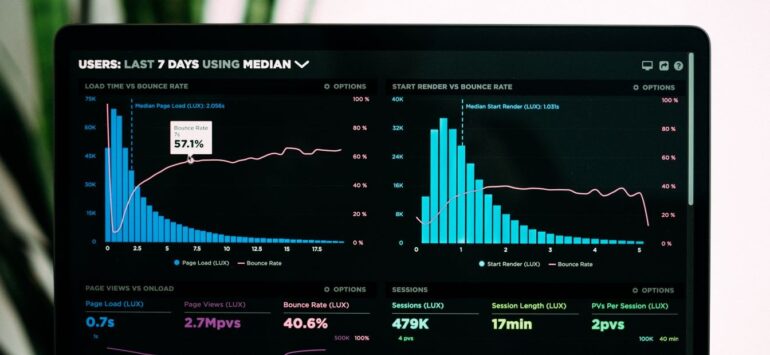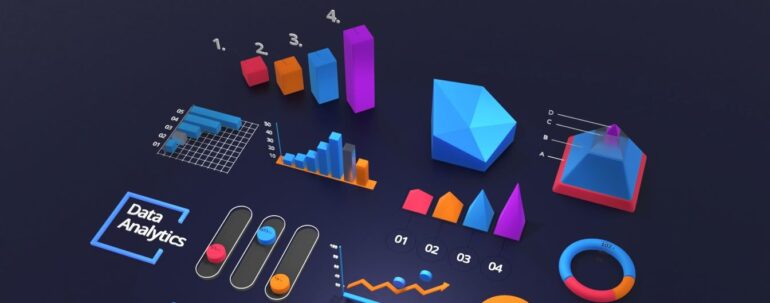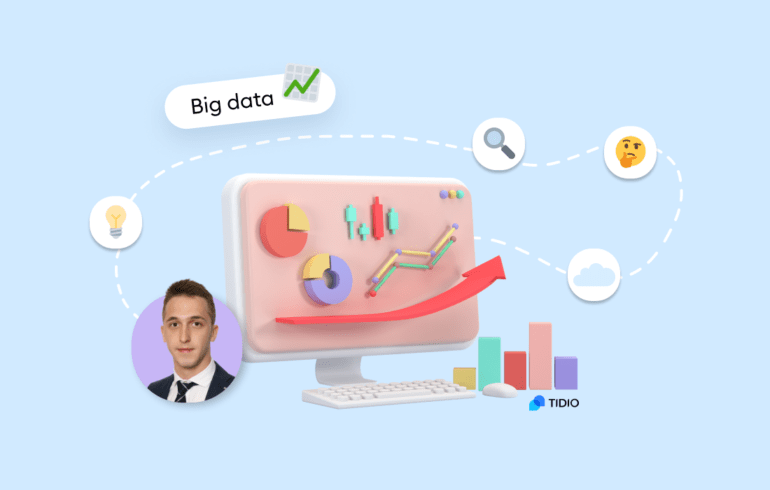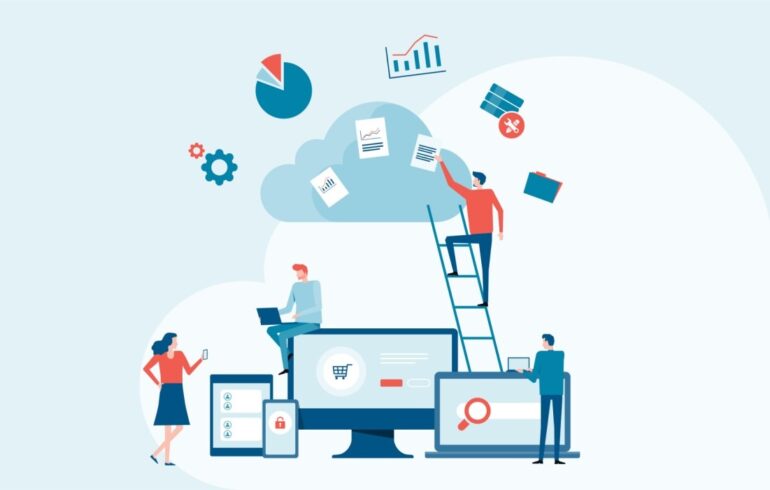Big Data w usługach finansowych: trendy na 2020

Wraz z rozwojem Internetu i technologii ludzkość tworzy i gromadzi coraz więcej różnego rodzaju danych. Takie ilości informacji były do tej pory bardzo trudne do przeprocesowania. Dopiero w ciągu ostatnich kilku lat powstały narzędzia umożliwiające przetworzenie ogromu danych w ułamkach sekundy. Fenomen ten na całym świecie został określony jako Big Data. Stwarza on wielkie możliwości rozwoju, zwłaszcza w sektorze finansowym, w którym analiza danych to chleb powszedni.
W poniższym artykule przedstawiamy siedem wiodących trendów Big Data w branży finansowej w 2020 roku.
Tom Potański. Właściciel softwarowej agencji konsultingowej DevsData LLC, która specjalizuje się w tworzeniu zaawansowanych rozwiązań softwarowych z wykorzystaniem technologii AI, Machine Learning oraz Big Data. Klienci DevsData to zarówno średnie przedsiębiorstwa, jak i wielkie międzynarodowe korporacje. Tom posiada wieloletnie doświadczenie w prowadzeniu biznesu z klientami z zagranicy, zwłaszcza ze Stanów Zjednoczonych, czego dowodem są liczne projekty rozwijane dla tamtejszych firm oraz startupów.
Humans are creating data at an exponential rate. In fact, 90% of the data in the world has been created in the past 2 years according to a 2015 IBM study. In the same study, it was estimated that we create 2.5 exabytes (2.5 quintillion bytes) of data every day. To put it in perspective, there are 18 zeros in a quintillion. As Big Data gets, well, bigger, it becomes even more important for executives and C-suites in financial services to stay ahead of the curve. And data creation isn’t slowing down anytime soon. According to the World Economic Forum, it’s estimated that by 2025, we will create 463 exabytes of data each day, the equivalent of 212 million DVDs each day.
The term “Big Data” has begun taking over as the newest buzzword in the finance industry.
Spis treści
But what does it really mean?
Big Data is the collective term used for contemporary technologies and methodologies used to collect, sort, process, and analyze massive, complex sets of data.
Simply put, Big Data encompasses every way we interact with huge sets of data.
The ultimate business goal of Big Data in the financial services industry is to gain insight from the data to push your business forward. There are many different analysis methods that can be performed on these datasets in order to optimize business growth, e.g. real-time analytics, customer analytics, and predictive analytics.
Simply put, analytics is the visible aspect of Big Data. However, if you want to take full advantage of the potential growth Big Data has to offer your company, you’ll need to dive deeper.
In this article, we will cover 7 of the top Big Data trends to look out for in the financial services industry in 2020 so you can keep your company up to date in the digital world.
CyberSecurity
Is Big Data used in CyberSecurity? Of course it is! Hadoop, Spark, Casandra are just a couple examples of BD technologies used in this industry.
In September 2017, Equifax reported a data breach that revealed the personal information of over half of Americans. In one of the biggest Big Data scares of the 21st century, 147 million people had their complete identities and extremely vulnerable information exposed. Since then, CyberSecurity has become one of the main Big Data priorities in the financial services industry.
Versive is a company that created software that they claim can help financial institutions and banks analyze massive transaction datasets and cybersecurity data using machine learning.
The software is called Versive Security Engine and is touted as being able to integrate easily with cloud, hybrid, or on-premises data structures. This software uses machine learning algorithms to find patterns and abnormalities in the data networks that could indicate potential cyber threats.
Versive claims they have helped Riaz Invest Limited improve security within customer data. They claim the Versive Security Engine was able to reduce the number of false positives in threat identification at Riaz.
Robo-Advisory Improves Customer Engagement
Robots aren’t just replacing truck drivers. They’re making their way into the financial sector and their next victim is the financial advisor.
Robo-advisors are being deployed to offer low-cost personalized financial portfolio advice to customers. Big Data analytics is now being used to passively manage portfolios without human intervention, strictly based on algorithms.
The first real robo-advisor, called Betterment, was launched in 2008. It offered investors access to asset rebalancing within target-date funds to manage passive investments. Even though human advisors already had this type of software, it was the first time investors could use it themselves without having to go through a human advisor.
It is predicted that in 2025 robo-advisors will act as digital platforms providing automated algorithm-led financial planning services without the need for human advisory. Such robo-advisors will first collect client data about their financial picture and their goals through surveys and use this data to automatically invest in assets and offer financial advice.
Simple versions of robo-advisors come in the form of chatbots, addressing simple customer inquiries, walking customers through the sales cycle, offering tips, advice, all while gathering customer data to help improve the customer experience.
According to Barron’s article, digital investment advice is poised to reach $1.26 trillion by 2023 as more everyday investors seek out low-fee robo-advisory.
Consumer Social Credit Score
Having lots of friends on Facebook or Instagram followers means popularity in certain social circles. Nowadays, your Facebook friend list may also impact your creditworthiness.
Neo Finance, Lend, and LendUp are a few of the growing number of credit businesses using personal data mined from social networks like Facebook, Twitter, and LinkedIn to analyze a consumer’s credit risk, according to an article in The Wall Street Journal. These companies believe a person’s social life, professional connections, and digital reputation should be considered as important factors when extending credit.
These startups aim to take advantage of a perceived downside to traditional loan criteria strictly based on FICO credit scores. While many people who lack borrowing experience or missed payments would be disregarded by traditional criteria, LendUp goal is to reconsider loan extensions by looking at people‘s social status.
For instance, perhaps recent immigration to the U.S. or a major medical emergency is dampening somebody’s credit score, while strong, active social ties and community connections may be a perceived indication of low risk. On the other hand, LendUp might find out that someone changed their phone numbers a lot, which is an indication of bad risk.
Mortgage Lending
As Big Data becomes more widespread in the financial services industry, mortgage lending will also face many changes in 2025. Between 2014 and 2017, mortgage industry spending on big data increased from $2.6 billion to $3.2 billion, according to Soma Metrics.
Similar to consumer social credit scores, mortgage applications are going to go beyond traditional data analysis methods and will begin incorporating social media data as well. Big Data will also be utilized in the application process to mine important inputs from public databases, bank records, and other websites to gather as much information on applicants as possible.
Another approach for the mortgage application process is to have homeowners finish their applications as usual, and then use the mortgage company’s pre-populated data to identify any discrepancies between the applications. This will ensure even greater accuracy and reduce the application process time for applicants. Additionally, it will also help determine the risk of identity theft. If there are too many discrepancies, applications could be flagged for further manual reviews with the applicants.
What is more, computer programs will also score applications using machine learning algorithms. Just as resume applications are now commonly being screened by artificial intelligence, mortgage lenders can use it to their advantage.
Based on the algorithms set up, applicants can be approved or denied immediately. Approved applications may be processed right away, while rejected applications may either be discarded or qualified for manual review. This will save mortgage lenders both time and money since human review will not be needed until applications pass through the initial screening. It will also reduce delays in the process, allowing for mortgage lenders to scale easier, reaching more clients.
Big Data analysis is also being used to price properties accurately. JPMorgan Chase is already using Big Data to accurately determine residential and commercial property sales prices that have been repossessed due to defaulted mortgages.
Thanks to combining data on local property markets, economic conditions, and information extracted by algorithms we will be able to recommend reasonable sales prices before any mortgage loans begin defaulting. With more accurate pricing any local property market shakeups from repossessions or defaults should be reduced. Also, there should be a reduction in the time period that a bank is forced to hold a property before making a new sale.
Optimising Protection & Mitigating Risk
As Big Data becomes more advanced it can also be used to optimize protection and mitigate risk.
Liability analysis functions can provide earlier warning signs of potential risk exposures. Financial institutions are able to be proactive in working with customers to limit liabilities and exposures to provide greater protection. Advanced customer data, transaction data, and geospatial data combined with advanced data analysis that looks at transaction anomalies will allow for easy risk detection and fraud prevention.
Ayasdi, an artificial intelligence software company, uses big data analytics through Ayasdi’s Model Accelerator (AMA), to help financial services companies model and predict regulatory risk with machine learning. They claim their software is able to help banks with regulatory compliance in anti-money laundering, which can automatically scan customer transaction data to reduce false positives and spot any anomalies in fraud detection.
Financial institutions and banks can easily integrate the software into their own enterprise data networks. The software’s algorithm will search through customer data and sales transactions to compare and test risk-models, including the probability of default, loss-given default, and other models. Then, the data insights can be easily viewed in a simple dashboard to discover current risks and predict potential risks.
Unified Data Analytics Platform Across Departments
n times past, large financial organizations that span their wings throughout different departments (retail banking, commercial banking, asset management, etc.) had to set up individual Big Data analytics platforms. This has made data mining and data transfer between the different business sectors extremely time-consuming and exhaustive.
However, in 2020, unified data analytics platforms will make it possible for large financial institutions to benefit from an easy-to-use data analysis system.
A big European financial group serving 40 million clients has recently hired DevsData & GetInData, a world-class team of software and data engineers, to build a unified solution for data processing across departments in 2019.
The client has been a leader in the financial services sector due to its advanced data processing and analytics. However, like most financial companies that have various business departments, it is very complicated trying to communicate different data points between various business units, as each uses a different analytics platform. With retail banking, commercial banking, direct banking, investment banking, asset management, and insurance services, there is a vast amount of data that has to be mined through different platforms.
The unified analytics platform will allow for customized data science environments to be created on-demand. Data scientists will be able to use their own personalized, dedicated work conditions using a simple user interface to create and deploy machine learning easily throughout the entire organization.
The platform will also make data management easier and ensure higher data quality. Data quality checks will be automatically implemented in Spark, resulting in less ingestion to speed the system up. On top of that, Apache Atlas will be used as the core component for data governance actions including data discovery, data tagging, business glossary.
The company is in the process of creating the next-generation, cloud-ready, unified Big Data Analytics Platform that will be based on an open-source stack. It will be one of the most advanced tech endeavors across all business departments whose primary industry isn’t technology.
Big data and hybrid cloud
Leveraging Big Data solutions such as Hadoop cluster definitely pays off for every single company that possesses voluminous amounts of data.
Of course, it requires some attention but comes with the advantage of having data in one place. Unfortunately, it is more than certain that one day you will meet the performance wall – the moment when you cannot add more processing due to hardware limitations. What to do in such a case? The best solution is to consider the hybrid cloud.
A hybrid cloud is an approach where a company can extend its internal capabilities with on-demand cloud infrastructure. This is a great solution in case you would like to quickly scale up your business and analyze all the data inputs much faster. What is great about this solution is that a hybrid cloud is fully configurable and the data is stored safely inside it.
Financial Services — The Wild West of Big Data
Big Data has rapidly made its way into the financial services industry as one of the most important roles in business optimization. However, as it turns out, the industry has been lagging behind, big time, compared to e.g. Media or Telecom.
Morgan Stanley’s Digitalization Index compares the top 34 sectors In terms of digital maturity, analyzing how far various sectors have developed within the digitalization path. Out of 34 sectors, you would imagine that financial services would be one of the top industries. But it ranked 18th, behind Utilities, Pharma, and Oil & Gas.
The financial industry has ever-increasing competition in a new era of Big Data. Personalizing the customer experience through robo-advisory, increasing cybersecurity to mitigate data breaches, and looking beyond credit scores into social scores are all at the forefront of Big Data changes in the financial sector.
Leading your organization from the front to compete in this new Wild West of Big Data is essential if you want to stay ahead of the pack.
Artykuł pierwotnie został opublikowany na blogu DevsData: https://devsdata.com/big-data-financial-services/
Źródło ilustracji: unsplash.com
Podobne artykuły

Podejście do zmniejszania kosztów przetwarzania danych na przykładzie Azure Databricks

Data management, data governance i data modernization - jak okiełznać proces zarządzania danymi w organizacji

Big Data - klęska urodzaju czy złoty Graal? Praktyczne metody wykorzystania potencjału danych

Dane 1,3 mln użytkowników Clubhouse do pobrania? To nie wyciek, to data scraping

Text clustering, czyli jak wyciągnąć realną wartość biznesową z milionów wiadomości tekstowych

Migracja do chmury? Wypełnij ankietę i sprawdź, jak wygląda ten proces u innych!

Analiza infrastruktury i danych IoT. Wybór bazy

